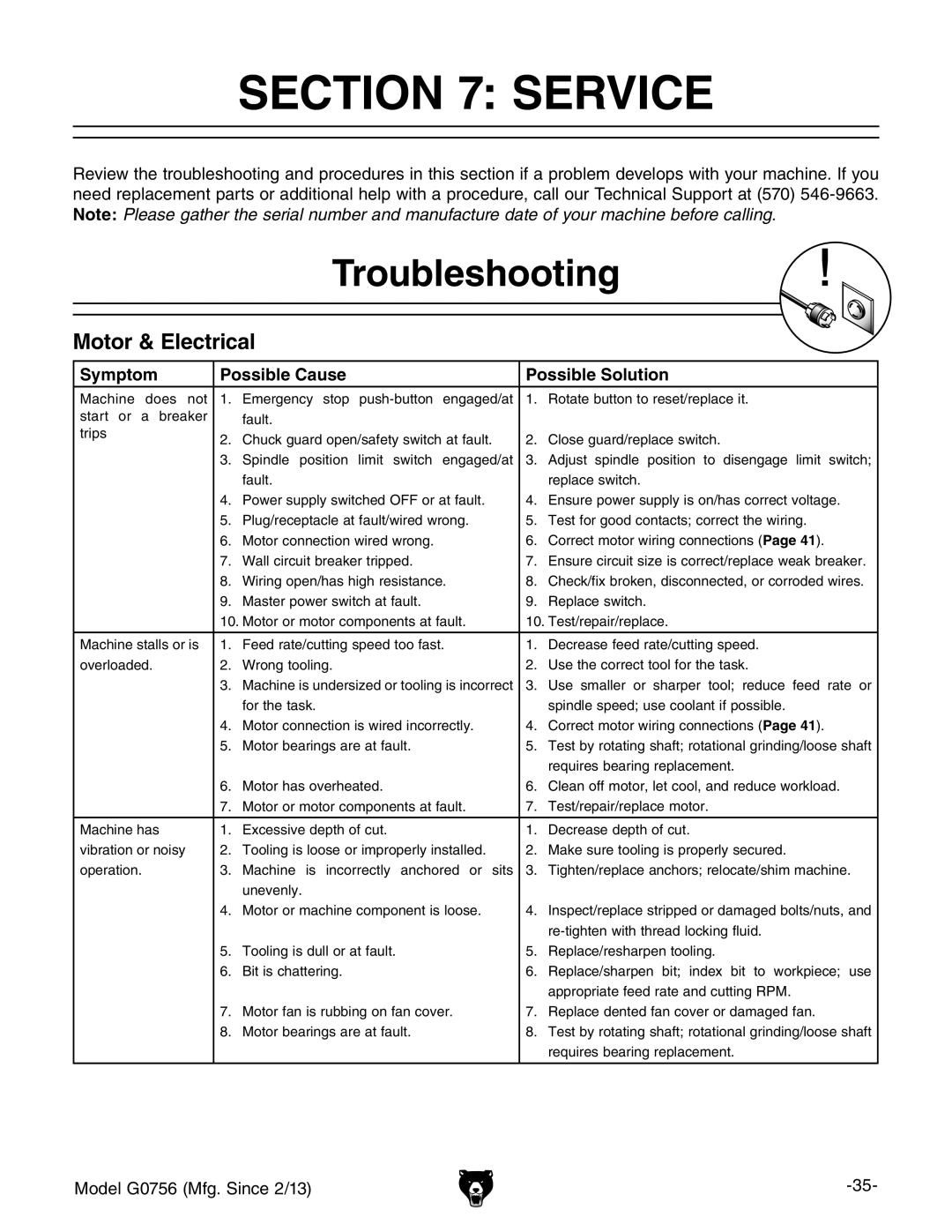
SECTION 7: SERVICE
Review the troubleshooting and procedures in this section if a problem develops with your machine. If you need replacement parts or additional help with a procedure, call our Technical Support at (570)
Troubleshooting
Motor & Electrical
Symptom | Possible Cause | Possible Solution | |||
Machine | does not | 1. | emergency stop | 1. | Rotate button to reset/replace it. |
start or | a breaker |
| fault. |
|
|
trips |
| 2. | Chuck guard open/safety switch at fault. | 2. | Close guard/replace switch. |
|
| ||||
|
| 3. | spindle position limit switch engaged/at | 3. | Adjust spindle position to disengage limit switch; |
|
|
| fault. |
| replace switch. |
|
| 4. | Power supply switched OFF or at fault. | 4. | Ensure power supply is on/has correct voltage. |
|
| 5. | Plug/receptacle at fault/wired wrong. | 5. | Test for good contacts; correct the wiring. |
|
| 6. | Motor connection wired wrong. | 6. | Correct motor wiring connections (Page 41). |
|
| 7. | Wall circuit breaker tripped. | 7. | Ensure circuit size is correct/replace weak breaker. |
|
| 8. | Wiring open/has high resistance. | 8. | Check/fix broken, disconnected, or corroded wires. |
|
| 9. | Master power switch at fault. | 9. | Replace switch. |
|
| 10. Motor or motor components at fault. | 10. Test/repair/replace. | ||
|
|
|
|
| |
Machine stalls or is | 1. | Feed rate/cutting speed too fast. | 1. | Decrease feed rate/cutting speed. | |
overloaded. | 2. | Wrong tooling. | 2. | Use the correct tool for the task. | |
|
| 3. | Machine is undersized or tooling is incorrect | 3. | Use smaller or sharper tool; reduce feed rate or |
|
|
| for the task. |
| spindle speed; use coolant if possible. |
|
| 4. | Motor connection is wired incorrectly. | 4. | Correct motor wiring connections (Page 41). |
|
| 5. | Motor bearings are at fault. | 5. | Test by rotating shaft; rotational grinding/loose shaft |
|
|
|
|
| requires bearing replacement. |
|
| 6. | Motor has overheated. | 6. | Clean off motor, let cool, and reduce workload. |
|
| 7. | Motor or motor components at fault. | 7. | Test/repair/replace motor. |
|
|
|
|
| |
Machine has | 1. | Excessive depth of cut. | 1. | Decrease depth of cut. | |
vibration or noisy | 2. | Tooling is loose or improperly installed. | 2. | Make sure tooling is properly secured. | |
operation. | 3. | Machine is incorrectly anchored or sits | 3. | Tighten/replace anchors; relocate/shim machine. | |
|
|
| unevenly. |
|
|
|
| 4. | Motor or machine component is loose. | 4. | Inspect/replace stripped or damaged bolts/nuts, and |
|
|
|
|
| |
|
| 5. | Tooling is dull or at fault. | 5. | Replace/resharpen tooling. |
|
| 6. | Bit is chattering. | 6. | Replace/sharpen bit; index bit to workpiece; use |
|
|
|
|
| appropriate feed rate and cutting RPM. |
|
| 7. | Motor fan is rubbing on fan cover. | 7. | Replace dented fan cover or damaged fan. |
|
| 8. | Motor bearings are at fault. | 8. | Test by rotating shaft; rotational grinding/loose shaft |
|
|
|
|
| requires bearing replacement. |
|
|
|
|
|
|
Model G0756 (Mfg. Since 2/13) |
